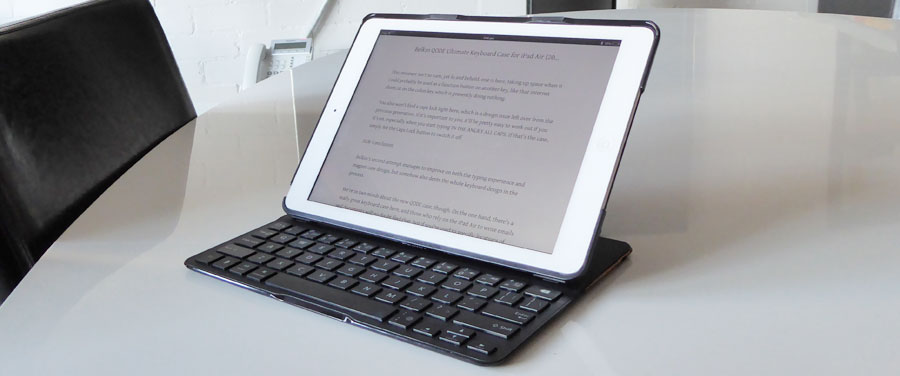And that leads us to the important part, which on a keyboard case is, understandably, the keyboard.
For the most part, the typing experience is enjoyable and comfortable, especially if you’re the sort that happily hunts and pecks with speed.
The island keys, also known as a “chiclet” keyboard, help to make the keys easy to press, and there’s enough travel to be comfortable but not feel like your fingers are striking down on something too shallow.
And it’s really nice to see that the edges that came up on the sides have been removed, filed down so that they’re flat and easy for your hands and palms to lay on, rather than feel confined in the small rectangular space that is the keyboard’s typing region.
Some keys, though, aren’t in the right space, and if you’re coming from a Mac keyboard — or really any regular keyboard for that matter — you may be a little confused, and end up typing wrong letter.
Like the colon and semi-colon key. This normally sits next to the “L” key on a keyboard, and yet in the latest incarnation of the Belkin Ultimate Keyboard, this has been changed to the odd location of the right of the space bar.
So, if you use the colon key and your fingers have memorised the placement, what you’ll actually end up typing is L. In reviews, for instance, we set them up with subheads, and so rather than type “SUB:” we found we were typing “SUBL.”
The curious thing about this is that there was no real reason to move the key, because even though the iPad Air is a different size from the older iPad 2 through 4 models, it’s not a dramatically different surface area.
But it’s not just a different positioning, with some smaller keys applied here, too. And with smaller keys, you may find yourself pressing keys that you didn’t expect, such as the enter key when you’re meant to be pressing the apostrophe and quote key.
This one got to us more often than others, because the enter key was closer than we expected, and often typing an apostrophe would give us the wrong character, providing a carriage return rather than the punctuation we actually needed.
If limited space is an issue, it doesn’t help that Belkin has provided a couple centimetres of margins on either side of the keyboard, which is room the company could probably have made work to its advantage.
And then there are keys which feel like they do nothing, like the function button for the colon key, which is mapped to open up a web browser when used in conjunction with the “Fn” button, but doesn’t seem to do a single thing.
Also, seriously, do we really need a dedicated key for Siri, and does it need to be in a more prominent position than the Alt or Command keys?
This reviewer isn’t so sure, yet lo and behold, one is here, taking up space when it could probably be used as a function button on another key, like that internet shortcut on the colon key which is presently doing nothing.
You also won’t find a caps lock light here, which is a design issue left over from the previous generation. If it’s important to you, it’ll be pretty easy to work out if you it’s on, especially when you start typing IN THE ANGRY ALL-CAPS. If that’s the case, simply hit the Caps Lock button to switch it off.

Conclusion
Belkin’s second attempt manages to improve on both the typing experience and magnet case design, but somehow also dents the whole keyboard design in the process.
We’re in two minds about the new QODE case, though: on the one hand, there’s a really great keyboard case here, and those who rely on the iPad Air to write emails and documents will no doubt find that, but if you’re used to specific locations of keys and you can’t change your learning, this will be a hard one to get used to thanks to some of the design decisions here.
If that doesn’t bother you, it’s a great addition to the iPad Air, especially if you want a keyboard that you can use on transport.



























